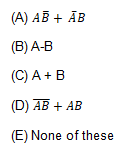Question
A box contains 21 ribbons out of which [A] ribbons are
white, and rest is green in colour. The probability of drawing a white ribbon and a green ribbon together is 18/35. Now, [B] green ribbons are added in the box such that the probability of drawing a green ribbon from the box is 1/2. Now, [C] yellow ribbons are added to the box such that the probability of drawing a yellow ribbon from the box is 1/5. Find the value of C-B?Solution
Let number of white ribbons in the box is ‘x’. Number of green ribbons in the box = (21 – x) According to question, [x × (21 – x)]/ 21C2 = 18/35 x (21 – x)/210 = 18/35 x (21 – x) = 18 × 6 x2 – 21x + 108 = 0 x = 12 or x = 9 So, the box contains either 12 white ribbons and 9 green ribbons or 9 white ribbons and 12 green ribbons. Now, if ‘B’ green ribbons are added and probability of drawing a green ribbon from the box becomes 1/2, it means number of green ribbons was less than number of white ribbons in the box initially. So, the numbers of white and green ribbons in the box initially were 12 and 9 respectively. Therefore, [A] = 12 and [B] = 3. Let number of yellow ribbons added in the box be ‘z’. So, [z/ (21 + 3 + z)] = 1/5 5z = z + 24 4z = 24 z = 6 So, [C] = 6 Required difference = 6-3 = 3
The Boolean expression for XOR gate is

The plateau located between Bhainsrorgarh to Bijolia is called-
‘Katargarh' was living area zone of which fort of Rajasthan ?
'Rajasthan Kabir Yatra' is related to which of the following field?
Koraput is related to which of the following Industry?
What is rancidity?
Which of the following is not correctly matched?
'Mission Palanhar' has been launched by which district administration to connect the underprivileged people with the Palanhar scheme?
The word "TRANSTAN" is associated with
__________ has the lowest record of population density having just 17 per square kilometre, as per census 2011.



